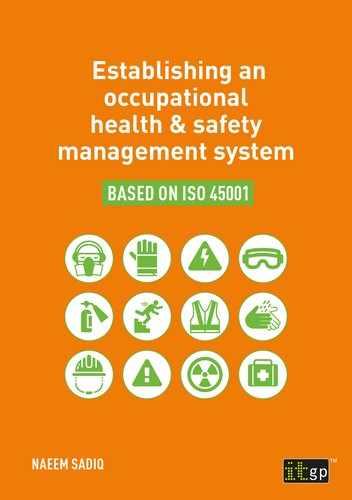0%
47Chapters
0-1Hours read
0kTotal Words
Table of Contents
- Cover
- Title
- Copyright
- Foreword
- About the Author
- Acknowledgements
- Contents
- Chapter 1: ISO 45001
- Chapter 2: Context of the organisation
- 2.1 Understanding the organisation and its context (ISO 45001:2018, Clause 4.1)
- 2.2 Understanding the needs and expectations of workers and other interested parties (ISO 45001:2018, Clause 4.2) .
- 2.3 Determining the scope of the OHSMS (ISO 45001:2018, Clause 4.3)
- 2.4 An example of the ‘scope’ of an organisation’s OHSMS
- 2.5 OHSMS (ISO 45001:2018, Clause 4.4)
- Chapter 3: Leadership
- Chapter 4: Organisational roles and worker participation
- Chapter 5: Planning
- 5.1 Actions to address risks and opportunities (ISO 45001:2018, Clause 6.1)
- 5.2 Hazard identification (ISO 45001:2018 Clause 6.1.2.1)
- 5.3 Assessment of OH&S risks and other risks to an OHSMS (ISO 45001:2018, Clause 6.1.2.2)
- 5.4 Assessment of OH&S and other opportunities for the OHSMS (ISO 45001:2018, Clause 6.1.2.3)
- Chapter 6: Determination of legal and other requirements (ISO 45001:2018, Clause 6.1.3)
- Chapter 7: Planning actions
- 7.1 Planning for risks and opportunities (ISO 45001:2018 Clause 6.1.4)
- 7.2 Planning to address legal and other requirements (ISO 45001:2018 Clause 6.1.4)
- 7.3 Planning to ‘prepare for’ and ‘respond to’ emergency situations (ISO 45001:2018 Clause 6.1.4)
- 7.4 Planning to integrate actions and evaluate their effectiveness (ISO 45001:2018 Clause 6.1.4)
- Chapter 8: OH&S objectives and their planning (ISO 45001:2018, Clause 6.2)
- Chapter 9: Competence and awareness (ISO 45001:2018, Clause 7.2)
- Chapter 10: Communication
- Chapter 11: Documented information
- 11.1 Documentation and ISO 45001 (Clause 7.5.1a)
- 11.2 Documented information required by ISO 45001
- 11.3 Documented information determined by an organisation (Clause 7.5.1b)
- 11.4 Documented information (documents and records)
- 11.5 Creating and updating documents (ISO 45001 Clause 7.5.2)
- 11.6 Control of documented information (ISO 45001 Clause 7.5.3)
- Chapter 12: Operational planning and control
- Chapter 13: Procurement
- Chapter 14: Emergency preparedness and response
- Chapter 15: Monitoring, measurement, analysis and performance evaluation
- 15.1 General (ISO 45001, Clause 9.1)
- 15.2 Requirements (ISO 45001, Clause 9.1.1)
- 15.3 Health monitoring and surveillance
- 15.4 Performance indicators and criteria
- 15.5 Measuring and monitoring equipment
- 15.6 Measuring and monitoring plan
- 15.7 Evaluation of regulatory compliance (ISO 45001, Clause 9.1.2)
- Chapter 16: Internal OHSMS audit
- 16.1 Why conduct internal audits? (ISO 45001, Clause 9.2.1)
- 16.2 Internal audit programme (ISO 45001, Clause 9.2.2)
- 16.3 Internal audit criteria and scope
- 16.4 Competence of auditors
- 16.5 Audit as a tool for continual improvement of OH&S performance
- 16.6 Implementing an OH&S internal audit programme
- 16.7 Documented information
- Chapter 17: OHSMS review
- Chapter 18: Continual improvement of the OHSMS
- Chapter 19: Continual improvement
- Chapter 20: Beyond ISO 45001
- Appendix A: A sample risk assessment for a small warehouse
- Appendix B: A 3x3 risk matrix for severity and likelihood
- Appendix C: A 5x5 risk matrix for severity and likelihood
- Appendix D: A 6x6 risk matrix for severity and likelihood
- Appendix E: A sample hazard identification and risk assessment procedure
- Appendix F: HAZOP
- Appendix G: A sample procedure for identifying and managing occupational health hazards
- Appendix H: A sample programme for occupational health surveillance
- Appendix I: An example of ‘planning’ to achieve OH&S objectives
- Appendix J: A sample procedure for competence, training and awareness
- Appendix K: Behaviour-based safety
- Appendix L: A sample procedure for critical pressure equipment
- Appendix M: A sample OH&S measuring and monitoring plan
- Appendix N: A sample of an OHSMS review input report
- Appendix O: A sample corrective action request form
- Bibliography
- Further reading
- Index
